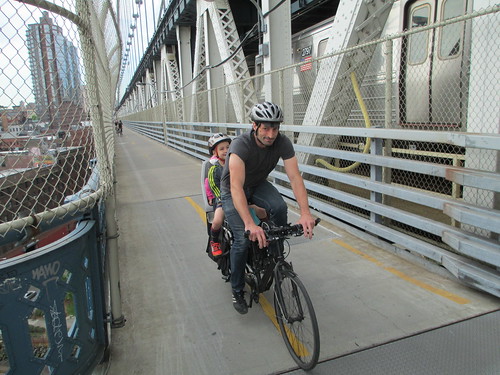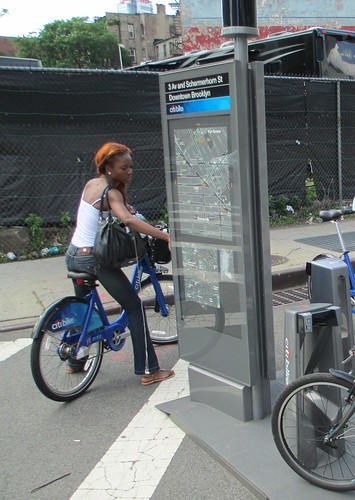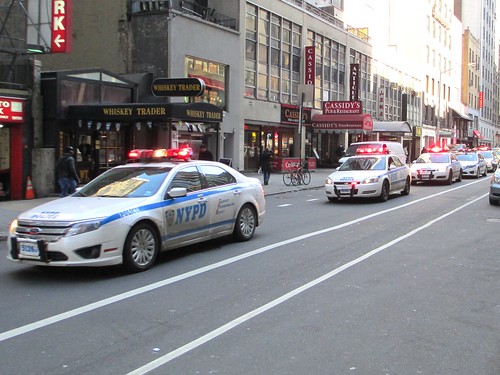It was as inconvenient a time for a work call as I can
imagine. I had grabbed my ringing phone from my pocket just as the lights
turned green at an intersection on the Invisible Visible Boy’s short route to
school. “I can’t talk now,” I shouted before stuffing the phone back into my
pocket, leaning heavily down on my pedal and getting myself, my bike, the boy and
his trailer bike all safely again into forward motion.
But, once I’d said goodbye to the boy and phoned back my
colleague in London ,
he didn’t immediately want to talk about the matter in hand. Instead, he made
me realise how thoroughly I’d taken for granted one of my key sources of
information about the world around me as I cycled. I’ve been noticing ever
since how many sounds I hear as I ride around – and how richly they add to my
experience.
“You didn’t ring off properly,” my colleague told me. “I
could hear the sound of the wind – and your son’s giggling.”
I had, I suppose, assumed before my colleague mentioned it
that most of the time while riding I wasn’t hearing very much. For much of my
journeys both to and from work, I work my way past long lines of waiting cars.
No-one’s saying a great deal. Even though it’s New York , people mostly don’t even bother
with honking. They just sit there.
 |
| Clinton St, Cobble Hill: very nice for people - and even, the Invisible Visible Man was surprised to hear, a hit with gentrifying birds |
But, the moment I started thinking about it, I recognised how
much information my hearing was giving me. The wind whistles in my ears, with
anything from a whisper to the full-throated, jet-engine roar of a seriously
stormy day. I hear the gentle whir of my bike’s rear hub. There’s the gentle
clicking as I change onto an easier gear and sometimes a slight clang as the
gear cable loosens and lets the chain slip down to a smaller sprocket. It’s a
good sign if I don’t hear very much. Recently, a tiny bit of water crept into
one of my pedals and I’ve run out of the grease I need to make it completely
quiet again. Every now and again it emits a little squeak, sending my stress
levels a little bit upwards.
Much of the time, as I pedal along steadily, songs play in my
head, to the rhythm of my breathing and pedalling. For a while now, for reasons
I don’t entirely understand, the tune seems to have been Lyle Lovett’s Walk Through the Bottomland – an obscure choice, even to me, but one whose
deliberate beat seems to fit with the way I cycle.
The bike’s interaction with the road makes its own sounds.
Occasionally, I’ll hit some stray stone on the road and send it flying –
thwack! – into a parked car. My mudguard (fender, American readers) gives off a
tiny bit of a vibrating sound – a very miniaturised version of an arrow hitting
a target – every time my front wheel jars into one of the countless
imperfections in the road surface. On the Brooklyn Bridge Queensboro Bridge and enjoyed the sensation of racing down into Queens on a surface made up of jointed concrete slabs –
ka-boom-ka-boom-ka-boom-ka-boom, steadily faster as I picked up speed. It’s
hard to sort out in my head which of these sounds is audible to the wider world
and which is conveyed direct from the road to my skull as the bike judders
against the crack in the road or the joint in the concrete.
There are sounds of place elsewhere, too. As I leave my
apartment, I hear subway trains growling complainingly around the Culver
Viaduct high above my head. Then, the other morning, in another part of Carroll Gardens Clinton Street that they were singing out
to each other one June morning rush hour. In some places, the audio soundtrack
actually provides far more of the atmosphere than what one can see. Riding over
the Manhattan Bridge Chinatown , I ran over one of the loose inspection covers.
“Clunk-clank!” it went as I too sent the sound of my own progress echoing off
the roadway’s underside.
 |
| This is how the bike lanes under the FDR Highway look. But the Invisible Visible Man hears the sound of the cars banging over the joints in the road above |
My sudden noticing of the birdsong, the sounds of the road
and the cacophony on the Manhattan
Bridge
None of that is to suggest, however, that the most
noticeable sounds don't cause me anxiety. The volume of honking gradually
rises each morning as I ride towards the Brooklyn Bridge Clinton Street emitting the strange
low-high-low hum of its hydraulic crushing mechanism. The honking reaches a
pitch as I struggle my way through TriBeCa. On Friday morning, an angry
motorist in a hurry slammed on her brakes when I stopped for a red light where Chambers Street
crosses the West Side Highway. She gave me a long, unmistakeably intimidatory
blast of her horn for having the temerity to stop her from running the light.
Those aren’t the only worry-inducing sounds. Any encounter with a
large, road-hogging SUV has an extra edge when it’s blaring out rap so loud
that the whole car vibrates. The motorists with most faith in honking’s
efficaciousness seem least ready to move aside for emergency vehicles and I
hear their drivers using their sirens to plead their way out of traffic. The
mixture of short blasts, honks and steady whines they emit sounds like nothing
so much as a pitiful trapped dog. Probably no motorist driving along Boerum
Place in downtown Brooklyn the other night was able to hear how desperately the
woman traipsing along the street at 11.30pm with a toddler son and luggage was
swearing as she pleaded for help or criticised or did whatever she was doing to
the person on the other end of her ‘phone call.
But the exposure to the stress is a flipside to the joy of
hearing all this sound. It’s a pleasure of cycling round the city that all my
senses are in immediate, unfiltered contact with the world around me, rather
than being filtered through tinted windows and soundproof doors. I’m
experiencing the city far more fully than I would in a car or a subway train.
That came home to me most fully late last summer, when I had
not long moved to New York. As I stopped for one of the last sets of lights
near my home, an old sedan drew up next to me, its windows rolled down. For a
few seconds, I was treated, wholly unexpectedly, to a blast of sublime 1960s
jazz, saxophones running riot over a pulsing bass line. I looked over at the
driver. We both smiled, surprised to find ourselves sharing a brief
transcendent moment of musical appreciation.








